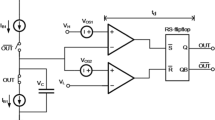Abstract
A temperature-compensated high-frequency CMOS integrated relaxation oscillator with low frequency variations is presented. A current-controlled oscillator topology is employed with a resistive source-degenerated transconductor and a current comparator to achieve high oscillation frequency and low power dissipation. The proposed oscillator was designed with process parameters from a standard 0.35-\(\upmu \)m CMOS technology and a 2.5-V single power supply voltage. At a nominal oscillation frequency of 21 MHz, the total power dissipation of the circuit was 201 \(\upmu \)W. Post-layout simulation results showed that the frequency variations were less than \({34.16\,\hbox {ppm}/{^{\circ }\hbox {C}}}\) over a temperature range of \(-40\) to \(+120\,^{\circ }\hbox {C}\).











Similar content being viewed by others
References
J. Bae, K. Song, H. Lee, H. Cho, H.-J. Yoo, A low-energy crystal-less double-FSK sensor node transceiver for wireless body-area network. IEEE J. Solid State Circuits 47(11), 2678–2692 (2012)
Y. Cao, P. Leroux, W. De Cock, M. Steyaert, A 63,000 Q-factor relaxation oscillator with switched-capacitor integrated error feedback. In 2013 IEEE International Solid-State Circuits Conference Digest of Technical Papers (ISSCC) (2013), pp. 186–187
Y.-H. Chiang, S.-I. Liu, A submicrowatt 1.1-MHz CMOS relaxation oscillator with temperature compensation. IEEE Trans. Circuits Syst. II Express Briefs 60(12), 837–841 (2013)
V. De Smedt, P. De Wit, W. Vereecken, M.S.J. Steyaert, A 66 \(\mu \)w 86 ppm/\(^\circ \)c fully-integrated 6 MHz Wienbridge oscillator with a 172 dB phase noise FOM. IEEE J. Solid State Circuits 44(7), 1990–2001 (2009)
U. Denier, Analysis and design of an ultralow-power CMOS relaxation oscillator. IEEE Trans. Circuits Syst. I Reg. Pap. 57(8), 1973–1982 (2010)
P.F.J. Geraedts, E.A.J.M. van Tuijl, E.A.M. Klumperink, G.J.M. Wienk, B. Nauta, Towards minimum achievable phase noise of relaxation oscillators. Int. J. Circuit Theory Appl. 42, 238–257 (2012)
K.-K. Huang, D.D. Wentzloff, A 1.2-MHz 5.8-\({\mu } {W}\) temperature-compensated relaxation oscillator in 130-nm CMOS. IEEE Trans. Circuits Syst. II Express Briefs 61(5), 334–338 (2014)
A. Paidimarri, D. Griffith, A. Wang, A.P. Chandrakasan, G. Burra, A 120 nW 18.5 kHz RC oscillator with comparator offset cancellation for \(\pm \)0.25 % temperature stability. In 2013 IEEE International Solid-State Circuits Conference Digest of Technical Papers (ISSCC) (2013), pp. 184–185
A. Rodriguez-Vazquez, R. Dominguez-Castro, F. Medeiro, M. Delgado-Restituto, High resolution CMOS current comparators: design and applications to current-mode function generation. Analog Integr. Circuits Signal Process. 7(2), 149–165 (1995)
F. Sebastiano, L.J. Breems, K.A.A. Makinwa, S. Drago, D.M.W. Leenaerts, B. Nauta, A 65-nm CMOS temperature-compensated mobility-based frequency reference for wireless sensor networks. IEEE J. Solid State Circuits 46(7), 1544–1552 (2011)
Y.-C. Shih, B. Otis, An on-chip tunable frequency generator for crystal-less low-power WBAN radio. IEEE Trans. Circuits Syst. II Express Briefs 60(4), 187–191 (2013)
K. Sundaresan, P.E. Allen, F. Ayazi, Process and temperature compensation in a 7-MHz CMOS clock oscillator. IEEE J. Solid State Circuits 41(2), 433–442 (2006)
T. Tokairin, K. Nose, K. Takeda, K. Noguchi, T. Maeda, K. Kawai, M. Mizuno, A 280 nW, 100 kHz, 1-cycle start-up time, on-chip CMOS relaxation oscillator employing a feedforward period control scheme. In 2012 Symposium on VLSI Circuits (VLSIC) (2012), pp. 16–17
Y. Tokunaga, S. Sakiyama, A. Matsumoto, S. Dosho, An on-chip CMOS relaxation oscillator with voltage averaging feedback. IEEE J. Solid State Circuits 45(6), 1150–1158 (2010)
H. Traff, Novel approach to high speed CMOS current comparators. Electron. Lett. 28(3), 310–312 (1992)
Y. Tsividis, C. McAndrew, Operation and Modeling of the MOS Transistor (Oxford University Press, New York, 2011)
L. Yan, G. Yuan, L. Der, W.-H. Ki, C.P. Yue, A 0.5 % precision on-chip frequency reference with programmable switch array for crystal-less applications. IEEE Trans. Circuits Syst. II Express Briefs 60(10), 642–646 (2013)
Author information
Authors and Affiliations
Corresponding author
Rights and permissions
About this article
Cite this article
Sakphrom, S., Georgiou, P. & Thanachayanont, A. A Sub-\({100\,\hbox {ppm}/{^{\circ }\hbox {C}}}\) Temperature-Compensated High-Frequency CMOS Relaxation Oscillator. Circuits Syst Signal Process 35, 29–42 (2016). https://doi.org/10.1007/s00034-015-0057-x
Received:
Revised:
Accepted:
Published:
Issue Date:
DOI: https://doi.org/10.1007/s00034-015-0057-x




